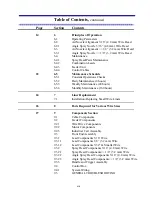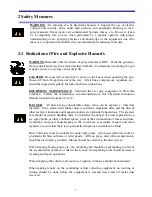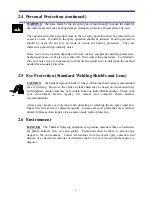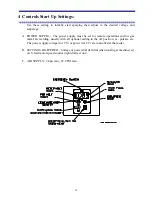
3
2 Safety Measures
WARNING
Arc spraying can be hazardous because it requires the use of electric
voltages and currents, hoses under high pressure, and potentially irritating or toxic
spray materials. It may involve air contaminated by dusts, fumes, etc,. However, it can
be a completely safe process when performed by a capable operator with proper
understanding of arc spraying practices and knowledge of the equipment, one who
takes care in operation and follows the recommended precautionary measures.
2.1 Reduction of Fire and Explosive Hazards
WARNING
Remember that the stream of sprayed metal is HOT. Point the gun away
from yourself and away from materials that will burn. Carelessness in pointing the gun
at paper, wood, or oily rags can result in fire.
CAUTION
Be especially careful not to spray on the hoses when operating the gun.
Hoses will burn. Keep them out of the way. All air lines, compressors, regulators, etc.,
should be inspected regularly for leaks and loose connections.
EQUIPMENT MAINTENANCE
:
Maintain the arc spray equipment in first-class
condition. Follow the maintenance recommendations in this Thermion Instruction
Manual located in Sections 6.4-6.5.4.
DANGER
: All dust, having considerable caloric value, can be explosive. This dust
includes: flour, starch, hard rubber dust, wood flour, aluminum dust, and the dust of
other metals. Aluminum and magnesium dusts are particularly hazardous. The greatest
care should be used in handling them. To minimize the danger of a dust explosion in an
arc spray booth or other confined spaces, prevent the accumulation of fumes and dust.
Ventilation and good housekeeping in the work area is essential. Inspect and clean
regularly to assure that there is no potentially dangerous accumulation of dust.
Dust Collectors must be suitable for metal spray dust. All closed collectors must be
provided with blowout holes or relief panels. All fans, pipes, dust colletors and motors
should be electrically grounded. Motors should be external to the dust system.
When cleaning booths, pipes, etc., the ventilating fan should be kept running to prevent
the accumulation of fumes or dust in the system. Non-sparking tools should be used in
cleaning and repair operations.
When emptying the collector, all sources of ignition in the area should be eliminated.
When making repairs on the ventilating or dust collecting equipment, no welding or
cutting should be done before the equipment is washed down and all metal dust
removed.
Summary of Contents for BRIDGEMASTER
Page 20: ...7 3 System Assembly drawing shows optional straighteners...
Page 30: ...17 6 2 1 Angle Spray Nozzle 3 16 4 8 mm Wire Head...
Page 31: ...18 6 3 Air Nozzle Alignment 1 8 3 2 mm Wire Head...
Page 32: ...19 6 3 2 Angle Spray Nozzle 1 8 3 2 mm Wire Head...
Page 57: ...44 9 4 1 System Wiring...
















































